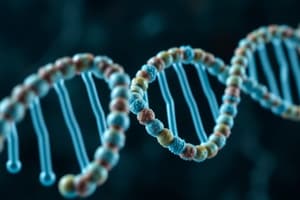Podcast
Questions and Answers
Which nitrogenous base is unique to DNA?
Which nitrogenous base is unique to DNA?
- Guanine
- Adenine
- Thymine (correct)
- Cytosine
What type of bond forms the sugar-phosphate backbone of a nucleic acid strand?
What type of bond forms the sugar-phosphate backbone of a nucleic acid strand?
- Covalent bonds between phosphates
- 5'-3' phosphodiester bonds (correct)
- Hydrogen bonds between bases
- Ionic bonds between nucleotides
What is released during the formation of a phosphodiester bond?
What is released during the formation of a phosphodiester bond?
- A nitrogenous base
- A nucleotide
- A carbohydrate
- Pyrophosphate (correct)
Which of the following is a purine found in DNA?
Which of the following is a purine found in DNA?
During DNA polymerization, what is the role of deoxynucleotide triphosphates (dNTP)?
During DNA polymerization, what is the role of deoxynucleotide triphosphates (dNTP)?
What is released when the two unused phosphate groups from dNTP are removed?
What is released when the two unused phosphate groups from dNTP are removed?
What is the configuration of the free groups at the ends of a newly formed DNA strand?
What is the configuration of the free groups at the ends of a newly formed DNA strand?
Which component is primarily responsible for driving the process of nucleotide polymerization?
Which component is primarily responsible for driving the process of nucleotide polymerization?
Flashcards are hidden until you start studying
Study Notes
Nitrogenous Bases in DNA
- DNA contains four nitrogenous bases: adenine, guanine, cytosine, and thymine.
- Purines are two-ringed structures; they include adenine and guanine.
- Pyrimidines are single-ringed structures; they include cytosine and thymine.
- Thymine is exclusive to DNA and does not appear in RNA.
Nucleoside Triphosphate Structure
- Nucleoside triphosphates (NTPs) are nucleotide units consisting of a nitrogenous base, a sugar, and three phosphate groups.
- NTPs are linked by 5'-3' phosphodiester bonds, forming covalent connections between nucleotides.
- Phosphodiester bonds create a sugar-phosphate backbone, integral for the structure of nucleic acid strands.
DNA Polymerization Process
- Deoxynucleotide triphosphates (dNTPs) are the building blocks used during DNA synthesis.
- During polymerization, pyrophosphate is released when two terminal phosphates are removed from dNTPs.
- The resulting nucleic acid strand has a free phosphate group at its 5' end and a free hydroxyl group at its 3' end.
- The hydrolysis of pyrophosphate releases energy that drives the polymerization of nucleotides.
Studying That Suits You
Use AI to generate personalized quizzes and flashcards to suit your learning preferences.



